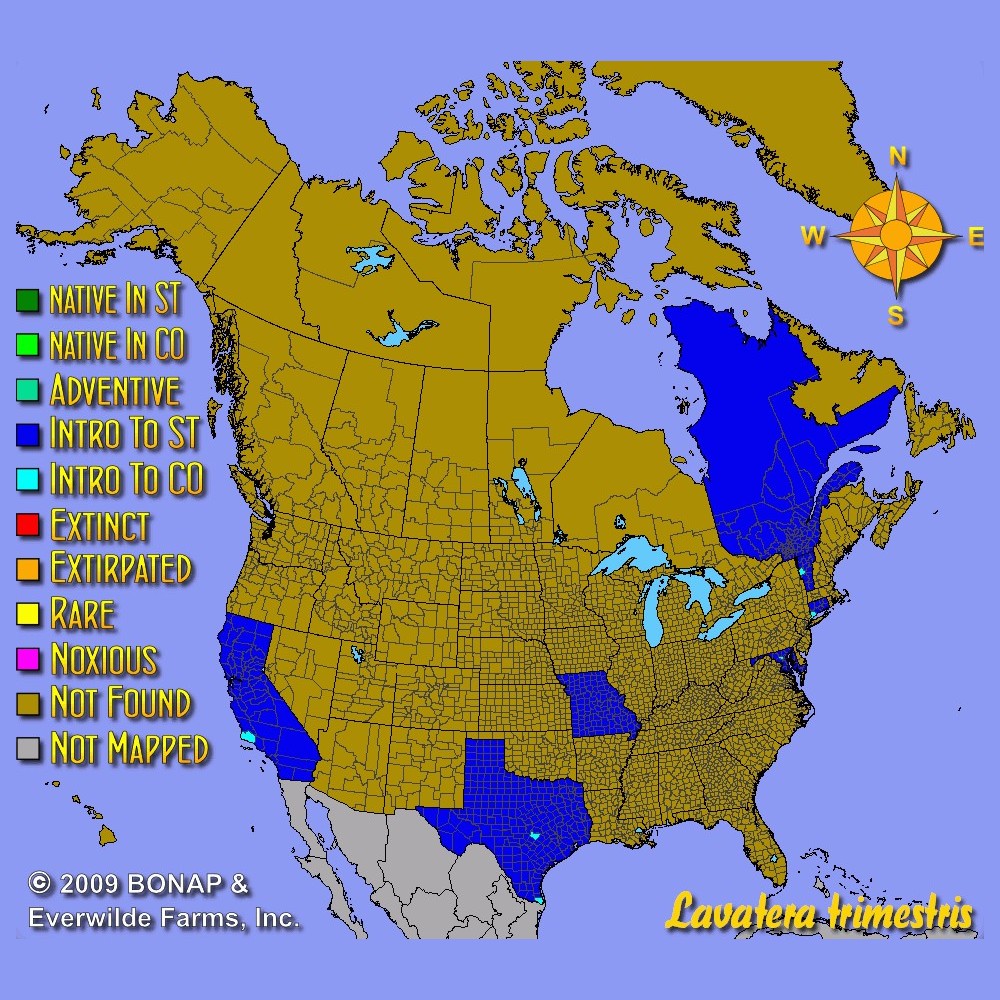Tree Mallow Seeds
Lavatera trimestris
- HOW TO GROW
- FAST FACTS
HOW TO GROW
Sowing: Direct sow as soon as the soil can be worked in the spring. Sow the Lavatera Trimestris seed just below the surface of the soil and keep it lightly moist until germination, which should occur within 14-21 days. For a longer bloom time, sow additional seed every two weeks. The tree mallow seed can also be started indoors 6-8 weeks before the last frost, for an earlier start. Plant three seeds each in large peat pots, planting them just below the surface and keeping the soil lightly moist until germination. Transplant seedlings after the last frost, taking care not to disturb the sensitive roots.
Growing: Water the young plants occasionally as they develop, since dry soil at this stage can stunt their growth. In addition to being extremely hardy in cold temperatures, mature plants can tolerate some drought and need little attention, though support may be helpful for taller plants. Do not over fertilize mature plants, as this tends to produce abundant foliage and few blooms. Transplanting is not recommended, since the tree mallow plant does not like having its roots disturbed. Deadhead spent flowers for continued bloom, leaving some at the end of the season to produce seed for another crop next season.
Harvesting: These delicate blossoms make excellent cut flowers. Choose stems with flowers that have just opened, and place them in water immediately. Strip the foliage that will fall below the surface of the water. Fresh flowers should last approximately 7-10 days. Either single flowers or entire plants can easily be dried.
Seed Saving: After the flowers wilt, a papery tan husk will form. The disc-shaped seed head will turn black when ripe. Remove the heads as soon as they ripen, since they will soon fall to the ground when dried; they can also mold if exposed to excessive moisture. Spread the seed heads out to dry and rub them lightly to separate the tree mallow seeds. Store the Lavatera Trimestris seeds in a cool, dry place.
FAST FACTS
Common Names: Rose Mallow, Annual Rose Mallow
Latin Name: Lavatera trimestris
Species Origin: Introduced US Wildflower
Type: Garden Flowers
Life Cycle: Annual
USDA Zones: 1, 2, 3, 4, 5, 6, 7, 8, 9, 10, 11, 12
US Regions: California, Mountain, Arid/Desert, Plains/Texas, Midwest, Northern, Northeast, Southeast
Seeds per Ounce: 4,800
Stratification: No Stratification
Germination Ease: No Stratification
Sunlight: Full Sun
Height: 36 Inches
Color: White, Pink
Bloom Season: Blooms Late Summer, Blooms Early Fall
DESCRIPTION

HOW TO GROW
Sowing: Direct sow as soon as the soil can be worked in the spring. Sow the Lavatera Trimestris seed just below the surface of the soil and keep it lightly moist until germination, which should occur within 14-21 days. For a longer bloom time, sow additional seed every two weeks. The tree mallow seed can also be started indoors 6-8 weeks before the last frost, for an earlier start. Plant three seeds each in large peat pots, planting them just below the surface and keeping the soil lightly moist until germination. Transplant seedlings after the last frost, taking care not to disturb the sensitive roots.
Growing: Water the young plants occasionally as they develop, since dry soil at this stage can stunt their growth. In addition to being extremely hardy in cold temperatures, mature plants can tolerate some drought and need little attention, though support may be helpful for taller plants. Do not over fertilize mature plants, as this tends to produce abundant foliage and few blooms. Transplanting is not recommended, since the tree mallow plant does not like having its roots disturbed. Deadhead spent flowers for continued bloom, leaving some at the end of the season to produce seed for another crop next season.
Harvesting: These delicate blossoms make excellent cut flowers. Choose stems with flowers that have just opened, and place them in water immediately. Strip the foliage that will fall below the surface of the water. Fresh flowers should last approximately 7-10 days. Either single flowers or entire plants can easily be dried.
Seed Saving: After the flowers wilt, a papery tan husk will form. The disc-shaped seed head will turn black when ripe. Remove the heads as soon as they ripen, since they will soon fall to the ground when dried; they can also mold if exposed to excessive moisture. Spread the seed heads out to dry and rub them lightly to separate the tree mallow seeds. Store the Lavatera Trimestris seeds in a cool, dry place.
FAST FACTS
Common Names: Rose Mallow, Annual Rose Mallow
Latin Name: Lavatera trimestris
Species Origin: Introduced US Wildflower
Type: Garden Flowers
Life Cycle: Annual
USDA Zones: 1, 2, 3, 4, 5, 6, 7, 8, 9, 10, 11, 12
US Regions: California, Mountain, Arid/Desert, Plains/Texas, Midwest, Northern, Northeast, Southeast
Seeds per Ounce: 4,800
Stratification: No Stratification
Germination Ease: No Stratification
Sunlight: Full Sun
Height: 36 Inches
Color: White, Pink
Bloom Season: Blooms Late Summer, Blooms Early Fall






